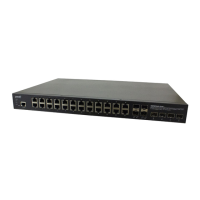Lantronix SISPM1040-xxxx-L3 Web User Guide
33856 Rev. A https://www.lantronix.com/ 38
extended to include aspects related to media streaming. Example product categories expected to adhere to this
class include (but are not limited to) Voice / Media Gateways, Conference Bridges, Media Servers, and similar.
Discovery services defined in this class include media-type-specific network layer policy discovery.
LLDP-MED Communication Endpoint (Class III): The LLDP-MED Communication Endpoint (Class III) definition
is applicable to all endpoint products that act as end user communication appliances supporting IP media.
Capabilities include all of the capabilities defined for the previous Generic Endpoint (Class I) and Media Endpoint
(Class II) classes, and are extended to include aspects related to end user devices. Example product categories
expected to adhere to this class include (but are not limited to) end user communication appliances, such as IP
Phones, PC-based softphones, or other communication appliances that directly support the end user.
Discovery services defined in this class include provision of location identifier (including ECS / E911 information),
embedded L2 switch support, inventory management.
LLDP-MED Capabilities: LLDP-MED Capabilities describes the neighbor unit's LLDP-MED capabilities. The
possible capabilities are:
1. LLDP-MED capabilities
2. Network Policy
3. Location Identification
4. Extended Power via MDI - PSE
5. Extended Power via MDI - PD
6. Inventory
7. Reserved
Application Type: Indicates the primary function of the application(s) defined for this network policy, advertised
by an Endpoint or Network Connectivity Device. The possible application types are shown below.
Voice - for use by dedicated IP Telephony handsets and other similar appliances supporting interactive voice
services. These devices are typically deployed on a separate VLAN for ease of deployment and enhanced
security by isolation from data applications.
Voice Signalling - for use in network topologies that require a different policy for the voice signalling than for
the voice media.
Guest Voice - to support a separate limited feature-set voice service for guest users and visitors with their
own IP Telephony handsets and other similar appliances supporting interactive voice services.
Guest Voice Signalling - for use in network topologies that require a different policy for the guest voice
signaling than for the guest voice media.
Softphone Voice - for use by softphone applications on typical data centric devices, such as PCs or laptops.
Video Conferencing - for use by dedicated Video Conferencing equipment and other similar appliances
supporting real-time interactive video/audio services.
Streaming Video - for use by broadcast or multicast based video content distribution and other similar
applications supporting streaming video services that require specific network policy treatment. Video
applications relying on TCP with buffering would not be an intended use of this application type.
Video Signalling - for use in network topologies that require a separate policy for the video signaling than for
the video media.
Policy: Policy indicates that an Endpoint Device wants to explicitly advertise that the policy is required by the
device. Can be either Defined or Unknown
Unknown: The network policy for the specified application type is currently unknown.
Defined: The network policy is defined (known).
TAG: Indicates whether the specified application type is using a tagged or an untagged VLAN. Can be Tagged or
Untagged.
Untagged: The device is using an untagged frame format and as such does not include a tag header as
defined by IEEE 802.1Q-2003.
Tagged: The device is using the IEEE 802.1Q tagged frame format.

